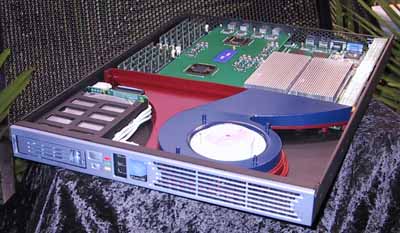Bij AnandTech is een uitgebreid artikel verschenen over het IDF, waarin een aantal nieuwe feiten naar boven drijven die in eerdere berichten nog niet zijn vermeldt. Zo heeft Intel bevestigd dat Pentium 4 Northwood geintroduceerd zal worden met een maximum kloksnelheid tussen de 2,1 en 2,5GHz, snelheden waarop de P7 core zich werkelijk kan afzetten tegen de op P6 gebaseerde Pentium III. Het 0.13 micron procédé van de nieuwe chip biedt volgens Intel genoeg ruimte voor 256KB extra L2 cache, maar ze hebben niet bevestigd dat ze dat ook daadwerkelijk zullen toepassen.
Verder heeft er een interessant gesprek met ServerWorks plaatsgevonden over de intrede van AMD in de servermarkt. Volgens hen is de Athlon op dit moment nog niet geschikt voor zware servers, omdat de FSB niet genoeg bandbreedte heeft (hoewel ze moeten toegeven dat de point-to-point EV6 bus veel goed maakt), PCI-X niet wordt ondersteund en het bedrijf er simpelweg niet genoeg geld in steekt. De 760MP chipset is volgens het bedrijf een stap in de goede richting, maar ServerWorks ziet pas brood in AMD als er 4 of 8-way Hammer systemen zijn.
Verder is er natuurlijk nieuws over het dual-McKinley systeem dat te zien was. Op de foto's is duidelijk te zien hoe men het klaarspeelt om 600 Watt aan hitte uit een 1U kastje af te voeren:
The fact that Intel has room to store the L3 cache on-die leads us to believe that McKinley will be a 0.13-micron chip which gives it approximately 50% die savings over the 0.18-micron Itanium. This could definitely help increase clock speeds and the yield of the McKinley to the point where it would potentially be a formidable contender in the 8-way server market. Only time will tell.
After just recently receiving the initial stepping of the McKinley processor from their manufacturing plants, Intel had multiple McKinley systems up and running copies of 64-bit Windows XP, 64-bit Linux and HP Unix. No one has ever argued with Intel's manufacturing capabilities, it is only when they try to push the architecture beyond its limits that problems occur (e.g. Pentium III 1.13GHz).
[...] The cartridge already saves some space, but we still have the issue of getting rid of the heat. The solution to this problem was to use a very large blower at the front of the 1U rack and blow a lot of air across the two heatsinks allowing the construction of a dual processor McKinley system in a 1U case. The impeller as they call it (essentially a blower) is capable of moving 70 cubic feet of air per minute at a rotational speed of 2800 RPM.[break]Als laatste nieuws meldt men dat de MTH (Memory Translator Hub) is opgestaan uit de dood. De originele twee MTH's waren terug te vinden op de i820 en i840 chipsets, beide hadden betrouwbaarheidsproblemen en het heeft Intel miljoenen gekost om de defecte moederborden te vervangen voor nieuwe exemplaren met RDRAM. Of Intel van haar fouten heeft geleerd zullen we over een tijdje vanzelf merken, op het schema van de i870 chipset voor Foster en McKinley processors vinden we namelijk de MRH-D terug, een Memory Repeater Hub voor DDR SDRAM. Gelukkig zullen de chipsets voor consumenten met ondersteuning voor DDR geheugen wel een 'echte' controller krijgen:[/break]The even bigger question is why would Intel release a McKinley chipset without a native DDR SDRAM controller? Maybe Intel is planning on bringing RDRAM to the server markets as well? It would make sense since it would be fairly easy to simply remove the MRH-D and replace the DDR SDRAM slots with RDRAM banks.
[...] We did make sure that the future DDR platforms for the desktop market would in fact be true DDR solutions and wouldn't use a MRH-D controller; luckily we did get confirmation of this. As you can see by the below block diagram of an upcoming desktop chipset codenamed "Plumas" it has an integrated DDR SDRAM controller.
Thanks meendering voor de tip.


